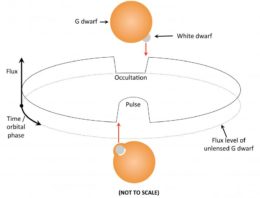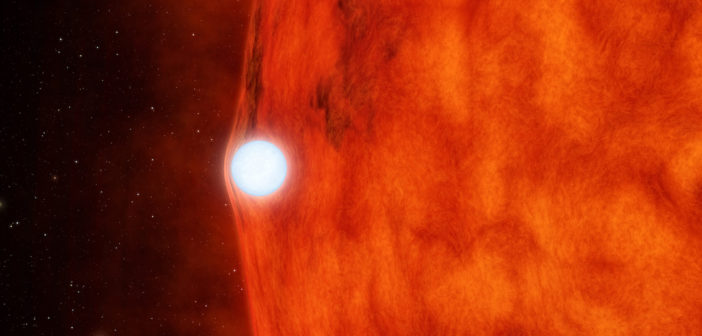Though Kepler’s primary mission ended years ago, the resulting dataset remains a vast playground in which astronomers continue to discover new surprises in stellar light curves. The latest? Evidence of a white dwarf that defies all expectations.
Forming a Lightweight

Artist’s impression of an extremely low-mass white dwarf (foreground) orbiting a more typical white dwarf (background). [CfA/David A. Aguilar]
But some observed white dwarfs have much lower masses — say, between 0.15 and 0.3 solar mass. To produce such a small remnant mass, the mass of the initial progenitor star would also have to be very low. But this poses a problem: smaller stars take longer to evolve, so a star of such low mass would need longer than the age of the universe to exhaust its fuel supply!
Since isolated stellar evolution can’t explain extremely low-mass white dwarfs, astronomers have settled on another explanation: binary interactions. In this scenario, the close orbit of two stars in a binary results in material being stripped away from the progenitor star, accelerating its mass loss and allowing it to evolve into a very low-mass white dwarf.
So far, this explanation has fit our observations. But now, the discovery of a new low-mass white dwarf is challenging our understanding.

Example diagram of a different self-lensing binary system, KOI-3278. When the white dwarf passes between us and the primary star, gravitational magnification causes a brightening in the light curve that we detect. For KIC 8145411, we do not observe an occultation, because the light from the white dwarf is too faint to detect directly. [Eric Agol]
Self-Lensing Surprise
In a new publication, a team of scientists led by Kento Masuda (NASA Sagan Fellow at Princeton University) present the discovery of the binary system KIC 8145411 from Kepler data. This unique binary is one of only five known self-lensing systems: one object in the binary gravitationally lenses the light of the other as it passes in front once per orbit.
Masuda and collaborators use follow-up observations from the Fred Lawrence Whipple Observatory in Arizona and the Subaru telescope in Hawaii to pin down the properties of the system, confirming that we’re looking at a 0.2 solar-mass white dwarf orbiting a Sun-like star in an edge-on, eclipsing orbit.
But here’s the catch: KIC 8145411’s orbit is quite wide, at 1.28 AU (a period of ~450 days) — ten times too wide for the primary and the white-dwarf progenitor to have interacted in the way we’d expect. How, then, did this “impossible” white dwarf come to exist?
Tip of the Iceberg

Masses of known white dwarfs in binaries and their orbital periods. The KIC 8145411 system is a clear outlier, having both a low mass and a very wide orbit. Click to enlarge. [Masuda et al. 2019]
So what’s next? The authors point out that we had only a 1 in 200 chance of detecting this particular system, due to its edge-on orientation — which likely means that KIC 8145411 is just the tip of the iceberg. Now that we know what we’re looking for, dedicated searches may turn up many more of these systems in the future — hopefully helping us to explain why this white dwarf is possible after all!
Citation
“Self-lensing Discovery of a 0.2 M⊙ White Dwarf in an Unusually Wide Orbit around a Sun-like Star,” Kento Masuda et al 2019 ApJL 881 L3. doi:10.3847/2041-8213/ab321b

3 Comments
Pingback: La curiosa binaria KIC 8145411 | Pablo Della Paolera
Pingback: Astronomers Have Spotted An "Impossible" White Dwarf | IFLScience
Pingback: An “Impossible” White Dwarf Identified in Kepler Data – Hamilton County Weather